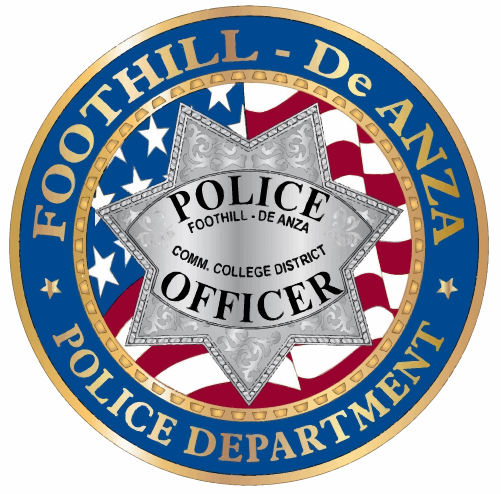ALPR & CAMERAS
automated license plate readers (ALPR)
In March 2023, the Foothill-De Anza Community College District Police Department installed three ALPR cameras at the Foothill campus to solve and reduce crime. The cameras are built and installed by Flock Safety the public safety technology company that helps neighborhoods, communities, and law enforcement work together to fight crime.
enforcement when a stolen car or known wanted suspect from a state or national crime database is detected. They also send alerts if a vehicle associated with a missing person in an AMBER or Silver Alert is detected.
The ALPR system also helps law enforcement solve crime by providing the objective evidence needed for investigations. According to the International Association of Chiefs of Police, 7 in 10 crimes are committed with a vehicle.
ALPR cameras capture license plates and vehicle characteristics, not people or faces. Each search requires a justification, and the data is never sold or shared with third parties. The cameras are used to solve and reduce property and violent crime, and are not intended for minor traffic or parking violations.
ALPR cameras are in use in thousands of cities across the country, and Flock Safety works with over 2,000 police departments. Communities using Flock Safety ALPR have reported crime reductions of up to 70%.
“At Flock Safety, we believe in building strong bonds between police departments and the citizens they pledge to protect, and we’re proud to partner with the Foothill-De Anza Community College DistrictPolice Department to help them in the pursuit of public safety,” - Garrett Langley, CEO Flock Safety.
What is ALPR?
Automatic License Plate Readers (ALPR) have long helped law enforcement solve crimes. ALPR's capture computer-readable images of license plates, allowing law enforcement agencies to compare plate numbers against those of stolen cars or cars driven by people suspected of being involved in criminal activities.
The information by ALPR cameras can help determine whether a vehicle was at the crime
scene and discover cars that may be associated with each other. Law enforcement agencies
can choose to share their information with other agencies. The cameras can also integrate
data from national or state crime databases to provide real time alerts when a vehicle
associated with a known suspect or a stolen vehicle passes the camera.
ALPR Flock Safety communities have reported overall crime reductions of over 70 percent after a period of time utilizing the ALPR system. In some areas, that included a 60 percent-plus reduction in non-residential burglaries, an 80 percent reduction in residential burglary, and a 40 percent-plus reduction in robberies.
What is Flock Safety?
Flock Safety is a public safety operating system that helps cities, businesses, schools, and law enforcement in thousands of communities work together to stop crime, protect privacy, and mitigate bias. We build hardware and write software that captures the objective evidence police need to solve crimes. Thousands of communities across the country use our proprietary devices and cloud-based software to help law enforcement solve upwards of 5 percent of all reported crime in America.
How do ALPR's help promote transparency and objectivity in policing?
Flock Safety ALPR technology is purpose-built to remove human bias from crime-solving. The ALPR cameras and machine learning technology are engineered to capture vehicle characteristics, types, and license plates, which are then checked against state and federal records to ensure accuracy and minimize errors.
Because license plate readers do not collect information on who is driving or riding in the vehicle, it is not considered Personally Identifiable Information (PII). Our technology does not capture images of pedestrians or passersby. The ALPR cameras take still images of cars passing through the lens (not video) and cannot follow or track vehicles once they leave the camera’s view.
ALPR's will never record names, phone numbers, or addresses and doesn’t mark specific locations where people have been. There is no capability in the system to mark or annotate the locations of passersby.
Finally, Flock Safety ALPR's are built to enable and encourage transparency, with several features that create robust audit capability. Both private and law enforcement customers must enter a reason for each search made through the Flock Safety system. That search history can be easily displayed for a community or law enforcement leadership to see what the ALPR's have been used for.
Public Safety Video Surveillance System
Pupose and Scope
This policy provides guidance for the placement and monitoring of department public
safety video surveillance, as well as the storage and release of the captured images.
This policy only applies to overt, marked public safety video surveillance systems
operated by
the Department. It does not apply to mobile audio/video systems, covert audio/video
systems or any other image-capturing devices used by the Department.
Policy
The Foothill-De Anza Community College District Police Department operates a public safety video surveillance system to complement its anti-crime strategy, to effectively allocate and deploy personnel, and to enhance public safety and security in public areas and Department locations.
Cameras may be placed in strategic locations throughout the District to detect and deter crime, to help safeguard against potential threats to the public, to help manage emergency response situations during natural and man-made disasters, and to assist District officials in providing services to the community. Video surveillance in public areas will be conducted in a legal and ethical manner while recognizing and protecting constitutional standards of privacy.
Operational Guidelines
Only department-approved video surveillance equipment shall be utilized. Members authorized to monitor video surveillance equipment should only monitor public areas and public activities where no reasonable expectation of privacy exists. The Chief of Police or the authorized designee shall approve all proposed locations for the use of video surveillance technology and should consult with and be guided by District Administration as necessary in making such determinations.
Placement and Monitoring
Only department-Camera placement will be guided by the underlying purpose or strategy associated with the overall video surveillance plan. As appropriate, the Chief of Police should confer with other affected District divisions and designated groups when evaluating camera placement. Environmental factors, including lighting, location of buildings, presence of vegetation or other obstructions, should also be evaluated when determining placement.
The cameras shall only record video images and not sound. Recorded images may be used for a variety of purposes, including criminal investigations and monitoring of activity around highvalue or high-threat areas. The public video surveillance system may be useful for the following purposes:
- Prevent, deter and identify criminal activity.
- Target identified areas of gang and narcotics complaints or activity.
- Respond to critical incidents.
- Assist in identifying, apprehending and prosecuting offenders.
- Document officer and offender conduct during interactions to safeguard the rights of the public and officers.
- Augment resources in a cost-effective manner.
- Monitor pedestrian and vehicle traffic activity.
Images from each camera should be recorded in a manner consistent with the underlying purpose of the particular camera. Images should be transmitted to monitors installed in Department approved locations. When activity warranting further investigation is reported or detected at any camera location, the available information should be provided to responding officers in a timely manner. Trained supervisory and Dispatch personnel are authorized to adjust the cameras to more effectively view a particular area for any legitimate public safety purpose.
The Chief of Police may authorize video feeds from the public safety video surveillance system to be forwarded to a specified location for monitoring by other than police personnel, such as allied government agencies, road or traffic crews, or fire or emergency operations personnel. Unauthorized recording, viewing, reproduction, dissemination or retention is prohibited.
Video Supervision
Supervisors should monitor video surveillance access and usage to ensure members are within department policy and applicable laws. Supervisors should ensure such use and access is appropriately documented.
Prohibited Activity
Public safety video surveillance systems will not intentionally be used to invade the privacy of individuals or observe areas where a reasonable expectation of privacy exists.
Public safety video surveillance equipment shall not be used in an unequal or discriminatory manner and shall not target individuals or groups based solely on actual or perceived characteristics such as race, ethnicity, national origin, religion, sex, sexual orientation, gender identity or expression, economic status, age, cultural group, or disability. Video surveillance equipment shall not be used to harass, intimidate, or discriminate against any individual or group.
Evidentiary Integrity
All downloaded and retained media shall be treated in the same manner as other evidence. Media shall be accessed, maintained, stored and retrieved in a manner that ensures its integrity as evidence, including strict adherence to chain of custody requirements. Electronic trails, including encryption, digital masking of innocent or uninvolved individuals to preserve anonymity, authenticity certificates and date and time stamping, shall be used as appropriate to preserve individual rights and to ensure the authenticity and maintenance of a secure evidentiary chain of custody.
Training
All department members authorized to operate or access public video surveillance systems shall receive appropriate training. Training should include guidance on the use of cameras, interaction with dispatch and patrol operations and a review regarding relevant policies and procedures, including this policy. Training should also address state and federal law related to the use of video surveillance equipment and privacy.

